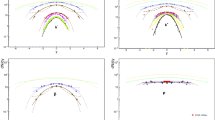Summary
A new method is introduced to account for conservation laws in the. statistical model of particle production. The approach becomes exact in the limit of high multiplicities: it leads to simple analytical expressions which allow immediate estimates of the influence of the various conservation laws under different circumstances. Momentum conservation is shown to have little influence on the energy spectra of the emitted particles; its consequences for the angular correlation of particles are studied. The statistical weight factors, which result from the coupling of the isospin vectors of the emitted particles with isospin conservation imposed, are shown to be well represented by semi-classical expressions; the dependence of the weight factors on total isospin and multiplicity becomes obvious. The general effects of angular momentum conservation in the statistical model are studied; the angular distributions are forward-backward symmetric in the c.m. system, a prediction specific to the model and a suitable test to its validity. In the classical approximation the angular distribution is forward-backward peaked, though not more than a limiting distribution 1/sinθ, whereθ is the angle of the particle with the beam direction. Angular momentum conservation leaves energy spectra nearly unchanged, while multiplicities are strongly affected by it; the effective interaction volumes in nucleon-antinucleon annihilation and nucleon-nucleon collisions are shown to be approximately the same, when this effect is taken into account.
Riassunto
Introduco un nuovo metodo per tener conto delle leggi di conservazione nel modello statistico della produzione di particelle. L’approssimazione diviene esatta nel limite delle alte molteplicità, e porta a semplici espressioni analitiche che permettono una valutazione immediata della influenza delle varie leggi di conservazione in differenti circostanze. Dimostro che la conservazione dell’impulso ha poca influenza sugli spettri d’energia delle particelle emesse; studio le sue conseguenze sulla correlazione angolare delle particelle. Mostro che i fattori statistici di peso, che risultano dall’accoppiamento dei vettori di isospin delle particelle emesse con l’imposta conservazione dell’isospin, sono ben rappresentati da espressioni semiclassiche; la dipendenza dei fattori di peso dall’isospin totale e dalla molteplicità diventa ovvia. Studio gli effetti generali della conservazione del momento angolare nel modello statistico; le distribuzioni angolari hanno simmetria antero-posteriore nel sistema del centro di massa, predizione speciflca di questo modello e prova attendibile della sua validità. Nella approssimazione classica la distribuzione angolare ha un picco antero-posteriore, però non superiore alla distribuzione limite 1/sinθ, in cuiθ è l’angolo della particella con la direzione del fascio. La conservazione del momento angolare lascia gli spettri di energia quasi invariati, mentre le molteplicità ne sono fortemente influenzate; dimostro che i volumi effettivi di interazione nella annichilazione nucleone-antinucleone e nelle collisioni nucleonenucleone sono approssimativamente uguali, se si tien conto di questo effetto.
Similar content being viewed by others
References
E. Fermi:Progr. Theor. Phys. (Japan),5, 570 (1950).
L. F. Cook: UCRL-8841 (1959).
Z. Koba:Nuovo Cimento,18, 608 (1960).
Y. Yeivin andA. De-Shalit:Nuovo Cimento,1, 1147 (1955).
V. S. Barašenkov andB. M. Barbašev:Suppl. Nuovo Cimento,7, 19 (1957).
F. Cerulus:Suppl. Nuovo Cimento,15, 402 (1960).
F. Cerulus:Nuovo Cimento,19, 528 (1961).
T. Ericson andV. Strutinski:Nucl. Phys.,8. 284 (1958);9, 689 (1958–59)
T. Ericson:Adv. in Phys.,9, 425 (1960).
R. Hagedorn:Nuovo Cimento,15, 434 (1960).
P. P. Srivastava andE. C. G. Sudarshan:Phys. Rev.,110, 765 (1958).
J. V. Lepore andR. N. Stewart:Phys. Rev.,94, 1724 (1954).
G. Goldhaber, S. Goldhaber, W. Lee andA. Pais:Phys. Rev.,120, 2250 (1960).
F. Cerulus:Nuovo Cimento,14, 827 (1959).
Ya. I. Granowskij andG. I. Kopylov:Soviet Physics, JETP,13, 125 (1961).
Author information
Authors and Affiliations
Additional information
On leave from the Institute of Theoretical Physics. Lund, Sweden.
Rights and permissions
About this article
Cite this article
Ericson, T. A new technique in the statistical model of particle production. Nuovo Cim 21, 605–632 (1961). https://doi.org/10.1007/BF02828797
Received:
Published:
Issue Date:
DOI: https://doi.org/10.1007/BF02828797




